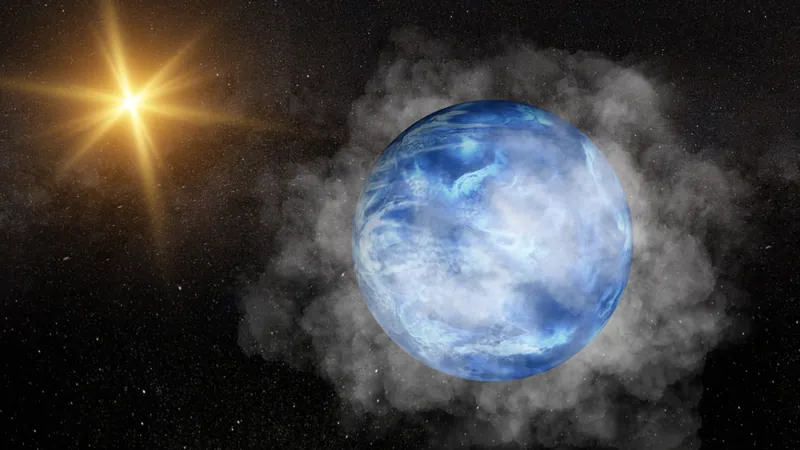
First-Ever 'Steam World' Discovered Near Earth by James Webb Space Telescope: What This Means for the Search for Alien Life
2024-10-11
Author: Amelia
Introduction
In a groundbreaking discovery, astronomers using the James Webb Space Telescope (JWST) have identified a nearby exoplanet that is unlike anything we’ve seen before. This unprecedented planet, designated GJ 9827 d, lies approximately 100 light-years away and is enveloped in an extraordinary atmosphere thick with steam.
Characteristics of GJ 9827 d
GJ 9827 d's characteristics are striking: it is roughly twice the size of Earth, has a mass three times greater, and its atmosphere is predominantly composed of water vapor. “This is the first time we're ever seeing something like this,” stated Eshan Raul, a researcher from the University of Wisconsin-Madison. “The planet appears to be made mostly of hot water vapor, leading us to call it a 'steam world.' However, it is important to note that this planet is not hospitable to the life forms we know of on Earth.”
Significance of the Discovery
While astronomers have theorized the existence of steam worlds for years, GJ 9827 d is the first to be directly observed. As Raul explained, although its extreme conditions make it unlikely to support Earth-like life, studying such planets can provide valuable insights into other small exoplanets that may be capable of supporting life.
Discovery Methodology
The research team, helmed by Caroline Piaulet-Ghorayeb from the University of Montréal, utilized a method called “transmission spectroscopy” to discern GJ 9827 d's steamy composition. This technique analyzes how light from a star interacts with a planet's atmosphere, identifying 'gaps' in the light spectrum that correspond to specific chemical elements and compounds.
Comparative Analysis of Atmospheres
Unlike other exoplanets predominantly found to have atmospheres of hydrogen and helium—common elements observable in gas giants like Jupiter and Saturn—GJ 9827 d showcases a rich mixture of heavier molecules typically associated with terrestrial planets in our solar system. Piaulet-Ghorayeb remarked, “GJ 9827 d is the first planet where we detect an atmosphere rich in heavy molecules—this is a huge step forward.”
Orbit and Previous Observations
Discovered in 2017 by the Kepler space telescope, GJ 9827 d orbits its host star at a distance of just 5.2 million miles (8.4 million kilometers), taking a mere six Earth days to complete one orbit. The Hubble Space Telescope initially hinted at the presence of water vapor in its atmosphere, but it was the advanced capabilities of the JWST that confirmed this world is not just full of water vapor—it's effectively swimming in it!
Excitement for the Future
“This was a surreal moment for us,” said Raul, referring to the team's work searching for water worlds. “The existence of such planets makes us wonder what else could be out there in the universe.”
Conclusion
Excitingly, the researchers believe that GJ 9827 d may be just the tip of the iceberg, hinting at a potentially vast population of similar 'steam worlds' awaiting discovery. Raul concluded by expressing hope for the future of young astronomers: “Working with the data from the most powerful telescope ever created shows that there has never been a better time to get involved in astronomy.”
Continuing the Search for Life Beyond Earth
With this incredible discovery, the search for life beyond Earth continues to deepen, urging scientists and enthusiasts alike to keep their eyes on the stars for more extraordinary finds. Could steam worlds be just the beginning of an enchanting cosmic journey? Stay tuned!









 Brasil (PT)
Brasil (PT)
 Canada (EN)
Canada (EN)
 Chile (ES)
Chile (ES)
 España (ES)
España (ES)
 France (FR)
France (FR)
 Hong Kong (EN)
Hong Kong (EN)
 Italia (IT)
Italia (IT)
 日本 (JA)
日本 (JA)
 Magyarország (HU)
Magyarország (HU)
 Norge (NO)
Norge (NO)
 Polska (PL)
Polska (PL)
 Schweiz (DE)
Schweiz (DE)
 Singapore (EN)
Singapore (EN)
 Sverige (SV)
Sverige (SV)
 Suomi (FI)
Suomi (FI)
 Türkiye (TR)
Türkiye (TR)